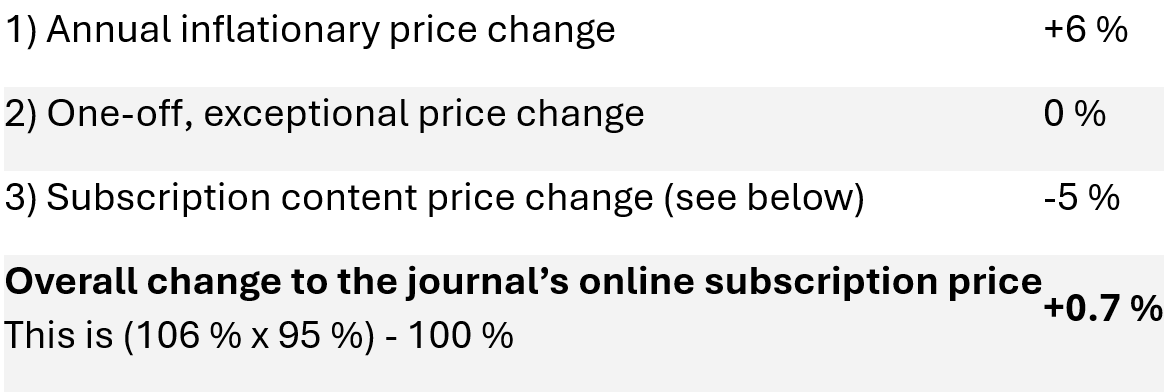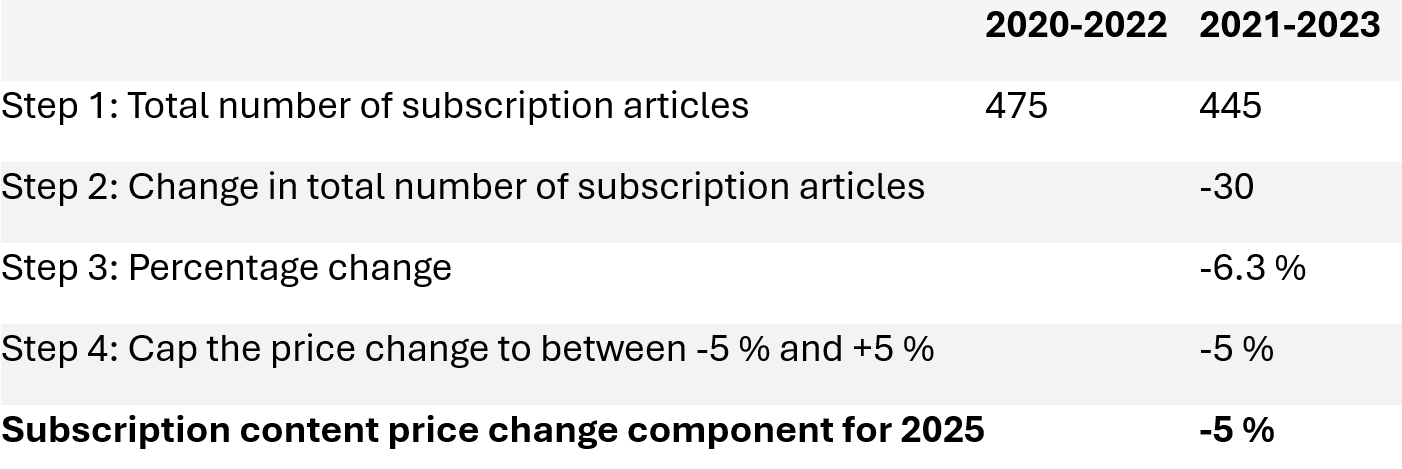It is unfair to ‘double dip’ by charging subscribers for open access content that has received funding through an institutional open access agreement, an article processing charge (APC), the Cambridge Open Equity Initiative, sponsorship from a third party, or some other mechanism.
Our pricing policy contains up to three components:
As we transition our journal research to fully open access, we will be conducting further reviews of our journals pricing policy to ensure we continue to operate a fair and sustainable model.
1) Annual inflationary price change: +6 %
2) One-off, exceptional price change: 0 %
3) Subscription content price change (see below): -5 %
Overall change to the journal’s online subscription price: +0.7 %
(This is (106 % x 95 %) - 100 %)


1) Annual inflationary price change: +6 %
2) One-off, exceptional price change: 0 %
3) Subscription content price change (see below): -5 %
Overall change to the journal’s online subscription price: +0.7 %
(This is (106 % x 95 %) - 100 %)
The subscription content component of our pricing policy (item 3 in the above) determines how we reduce the prices for online-only subscriptions during the transition to open access.
The price change is the percentage change in the total amount of subscription content over the two most recent three-year periods. The following two examples show how article data from 2020–2023 journal volumes was used in 2024 to determine the subscription content price change applied to the online-only prices for 2025 journal volumes:
Step 1: Total number of subscription articles: 2020-2022 = 475; 2021-2023 = 445
Step 2: Change in total number of subscription articles = -30
Step 3: Percentage change = -6.3 %
Step 4: Cap the price change to between -5 % and +5 % = -5 %
Subscription content price change component for 2025 = -5 %


Step 1: Total number of subscription articles: 2020-2022 = 475; 2021-2023 = 445
Step 2: Change in total number of subscription articles = -30
Step 3: Percentage change = -6.3 %
Step 4: Cap the price change to between -5 % and +5 % = -5 %
Subscription content price change component for 2025 = -5 %
Step 1: Total number of subscription articles: 2020-2022 = 475; 2021-2023 = 505
Step 2: Change in total number of subscription articles = +30
Step 3: Percentage change = +6.3 %
Step 4: Cap the price change to between -5 % and +5 % = +5 %
Subscription content price change component for 2025 = +5 %


Step 1: Total number of subscription articles: 2020-2022 = 475; 2021-2023 = 505
Step 2: Change in total number of subscription articles = +30
Step 3: Percentage change = +6.3 %
Step 4: Cap the price change to between -5 % and +5 % = +5 %
Subscription content price change component for 2025 = +5 %
The price change cap and the three-year measurement period help us avoid unnecessary price changes due to transient fluctuations in the amount of subscription content a journal publishes each year.
We will monitor the price caps to ensure they remain appropriate and allow journal subscription prices to be sufficiently reduced over time in line with the transition to open research. Additional price decreases may also be applied to a journal if necessary.